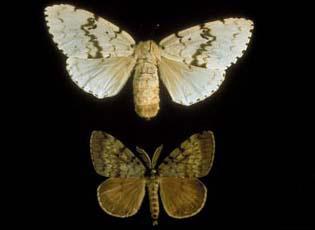Lymantria dispar Linnaeus (ITIS)
Spongy Moth; formerly known as European gypsy moth (EGM) or Gypsy moth (GM) (Entomological Society of America 2022)
Europe (CABI)
1869 (Smithsonian 1999)
Imported for silk production (Smithsonian 1999)
Defoliates trees (Smithsonian 1999)

European Gypsy Moth, Pinned specimen of adult European/North American female (top) and male (bottom); USDA, APHIS, Plant Protection and Quarantine Archives
Find more images
Spotlights
Distribution / Maps / Survey Status
Federally Regulated
Videos
All Resources
Selected Resources
The section below contains highly relevant resources for this species, organized by source.
Council or Task Force
Partnership
Federal Government
International Government
State and Local Government
Academic
Professional
Integrated Taxonomic Information System. Lymantria dispar. [Accessed Aug 10, 2023].
CABI. Invasive Species Compendium. Lymantria dispar (gypsy moth). CAB International. [Accessed Aug 10, 2023].
Smithsonian Institution. 1999. BugInfo: Gypsy Moths. Department of Systematic Biology, Entomology Section, National Museum of Natural History. Information Sheet 36.
Entomological Society of America. 2022. 'Spongy Moth' Adopted as New Common Name for Lymantria dispar.
